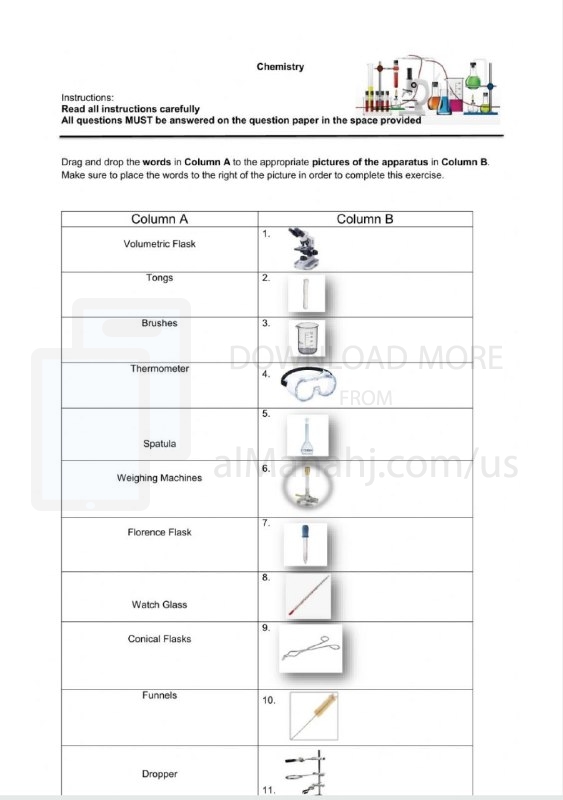| You are here: Almanahj Website ⇒ American curriculum ⇒ 7th Grade ⇒ Chemistry ⇒ Term 1 | ||
|---|---|---|
Worksheet about Equipment | ||
|---|---|---|
| Subject: Chemistry | ||
| 7th Grade | ||
| Term 1 | ||
| Year: 2023/2024 | ||
| Size: 258.4KB | ||
| Number of clicks: 36 | ||
| Publish date:November 05, 2023 | ||
| Added by: Eman | ||
| Last download date: 2024-09-08 10:17:44 | ||
| Updated by: Eman9966 on 2023-11-05 10:04:01 | By: theodor RyanBAR | |
File info: Equipment in chemistry refers to the various tools and apparatus used in laboratories and research settings to perform experiments, analyze substances, and carry out chemical processes. These equipment are specifically designed to handle and manipulate chemicals, measure quantities, control temperature, and ensure safety. Here are descriptions of some common equipment in chemistry:1. Burette: A burette is a long, graduated glass tube with a stopcock at the bottom. It is used to accurately measure and dispense precise volumes of liquids in titration experiments. 2. Bunsen Burner: A Bunsen burner is a gas burner used to heat substances in the laboratory. It produces a flame by mixing gas (such as natural gas) with air, allowing for controlled heating and combustion. 3. Balance: A balance is a device used to measure the mass of an object or substance. It provides accurate measurements by comparing the unknown mass to known masses. Balances can be digital or mechanical, and they are crucial for precise quantitative analysis. 4. Stirring Rod: A stirring rod, also known as a stirring rod or spatula, is a long, thin glass or metal rod with a rounded end. It is used to mix or stir substances within a container, ensuring uniformity and facilitating reactions. 5. Watch Glass: A watch glass is a small, concave, circular glass plate commonly used to hold small amounts of substances during experiments. It can also be used as a cover to prevent evaporation or contamination. 6. Pipette: A pipette is a slender, calibrated glass or plastic tube used to transfer precise volumes of liquids. It typically has a bulb or a mechanical device for aspiration and dispensing. Pipettes come in various sizes, including micropipettes for very small volumes. 7. Clamp: A clamp is a metal device with an adjustable grip used to secure laboratory glassware, such as flasks or beakers, to a support stand. It ensures stability and safety during experiments. 8. Flask: A flask, also known as a glass flask or Erlenmeyer flask, is a glass container with a narrow neck and a flat bottom. It is commonly used for holding, mixing, or heating liquids during chemical reactions or titrations. 9. Safety Goggles: Safety goggles are protective eyewear worn in the laboratory to safeguard the eyes from chemical splashes, fumes, and other potential hazards. They provide a barrier against potential eye injuries. 10. Thermometer: A thermometer is a device used to measure temperature. In chemistry, a common type is a glass thermometer with a long, narrow tube and a bulb at one end containing a temperature-sensitive liquid, such as mercury or alcohol. These are just a few examples of the equipment used in chemistry. Each piece of equipment serves a specific purpose and plays a vital role in conducting experiments, ensuring accuracy, and maintaining safety in the laboratory. | ||
| Downloading link Worksheet about Equipment |
|---|
|
1699178470.pdf
The file is being prepared for download
|
| File images |
|---|
 |